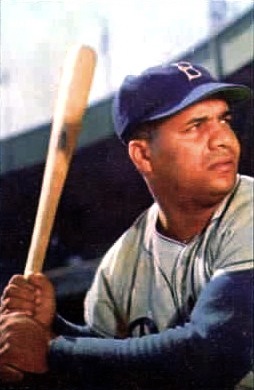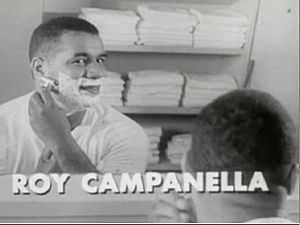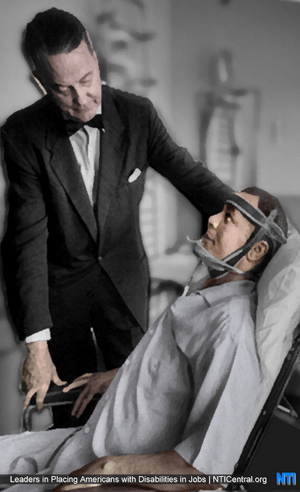Roy Campanella facts for kids
Quick facts for kids Roy Campanella |
|||
|---|---|---|---|
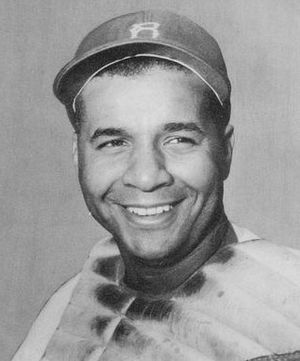
Campanella with the Brooklyn Dodgers in 1956
|
|||
| Catcher | |||
| Born: November 19, 1921 Philadelphia, Pennsylvania, US |
|||
| Died: June 26, 1993 (aged 71) Woodland Hills, California, US |
|||
|
|||
| Professional debut | |||
| NgL: 1937, for the Washington Elite Giants | |||
| MLB: April 20, 1948, for the Brooklyn Dodgers | |||
| Last appearance | |||
| September 29, 1957, for the Brooklyn Dodgers | |||
| Career statistics | |||
| Batting average | .283 | ||
| Hits | 1,401 | ||
| Home runs | 260 | ||
| Runs batted in | 1,017 | ||
| Stolen bases | 34 | ||
| Teams | |||
|
|||
| Career highlights and awards | |||
|
|||
| Induction | 1969 | ||
| Vote | 79.41% (seventh ballot) | ||
Roy Campanella (born November 19, 1921 – died June 26, 1993), known as "Campy", was an American baseball player. He was mostly a catcher, a player who squats behind home plate. Roy played in the Negro leagues and Mexican League for nine years. Then, in 1946, he joined the minor leagues. He started playing in Major League Baseball (MLB) in 1948 for the Brooklyn Dodgers. He played for them until 1957. Sadly, his playing career ended when he was paralyzed in a car accident in January 1958. Many people think he was one of the best catchers ever.
After his accident, Campanella worked for the Dodgers in different roles. He helped find new players and worked with the community. In 1969, he was added to the Baseball Hall of Fame.
Contents
Roy's Early Life and School
Roy Campanella was born in Philadelphia. His mother, Ida, was African American. His father, John, was the son of Italian immigrants. Roy was one of four children. They lived in different parts of Philadelphia. The children went to schools where all races learned together. Because he was of mixed race, Roy and his siblings sometimes faced unkindness from other kids.
Roy was a very talented athlete. He was chosen as captain for every sports team he played on in high school. But baseball was his favorite sport.
Roy's Baseball Career
Playing in the Negro Leagues
Because of his mixed race, Roy Campanella was not allowed to play in Major League Baseball at first. This was due to the "baseball color line," which kept black players out of the major leagues. In 1937, when he was 15, he started playing Negro league baseball. He played for the Washington Elite Giants on weekends. A few months later, on his 16th birthday, he left high school. This allowed him to play baseball full-time. The Elite Giants moved to Baltimore the next year. Campanella became a star player for them until 1945.
Playing in Mexico and Venezuela
In 1942, Campanella left the Baltimore Elite Giants after an argument. He spent the rest of that season and the 1943 season in the Mexican League. He played for the Monterrey Sultans. His manager there, Lázaro Salazar, told Roy he would one day play in the major leagues. Campanella then went back to the Elite Giants for the 1944–45 seasons.
In 1946, Campanella played in the new Venezuelan Professional Baseball League. He was a co-coach for the Sabios de Vargas team. He helped lead them to win the league championship.
Playing in the Minor Leagues
In 1946, Campanella joined the Brooklyn Dodgers' minor league system. The Dodgers were getting ready to break the MLB color barrier. They planned to do this with Jackie Robinson. Roy's friendly personality and hard work helped him get along with players of all races. Even though Branch Rickey thought about having Campanella break the color barrier, he chose Robinson instead.
For the 1946 season, Robinson played for the Montreal Royals. This was a top team linked to the Dodgers. On March 18, 1946, Campanella signed a contract to play for the Danville Dodgers. But the general manager there felt the league was not ready for racial integration. So, the Dodgers sent Campanella and pitcher Don Newcombe to the Nashua Dodgers. This team was in a league where they thought people would be more accepting. The Nashua team became the first professional baseball team in the 20th century to have both black and white players in the United States.
Campanella's 1946 season went well, with few racist problems. In one game, Campanella even became the manager. This happened after the regular manager, Walter Alston, was sent out of the game. Campanella was the first African American to manage white players on a professional baseball team. Nashua was losing by three runs when Campanella took over. They came back and won. This was partly because Campanella decided to use Newcombe as a pinch hitter. Newcombe hit a home run that tied the game.
Playing in Major League Baseball
Jackie Robinson played his first season in the major leagues in 1947. Campanella started his MLB career with the Brooklyn Dodgers the next year. His first game was on April 20, 1948. Later, Robinson and his wife sometimes stayed with the Campanella family. This was because it was hard for black people to find good hotels in some cities.
Campanella played for the Dodgers from 1948 to 1957. He was their main catcher. In 1948, he wore three different uniform numbers. He finally chose number 39 for the rest of his career.
Campanella was chosen for the All-Star Game every year from 1949 to 1956. In 1949, he was one of the first four African Americans to be All-Stars. (Jackie Robinson, Don Newcombe, and Larry Doby were also All-Stars that year.) In 1950, Campanella hit home runs in five games in a row. Only a few other Dodgers have done this.
Campanella won the Most Valuable Player (MVP) award three times. He won in 1951, 1953, and 1955. In each of these MVP seasons, he hit for a high average (over .300). He also hit more than 30 home runs. And he had over 100 runs batted in (RBI). His 142 RBI in 1953 was a team record at the time. Today, it is the second-highest in Dodgers history. That same year, Campanella hit 40 home runs while playing catcher. This was a record for catchers until 1996. During his career, he stopped 57% of base runners who tried to steal a base. This is the highest percentage for any catcher in major league history.
In 1955, Campanella helped Brooklyn win its first World Series championship. The Dodgers lost the first two games to the Yankees. But Campanella started their comeback in Game 3. He hit a two-run home run. The Dodgers won that game. He hit another home run in Game 4, tying the series. The Dodgers then won the series in seven games.
Campanella caught three no-hitters during his career. These were games where the other team got no hits. He caught two for Carl Erskine and one for Sal Maglie. Maglie said, "He was doing the thinking, calling the pitches just right... and all I had to do was check the sign... and then throw."
After the 1957 season, the Brooklyn Dodgers moved to Los Angeles. They became the Los Angeles Dodgers. But Campanella's playing career ended because of a car accident. He never played a game for Los Angeles.
Car Accident and Recovery
Campanella lived in Glen Cove, New York. He also owned a liquor store in Harlem. After closing his store on January 28, 1958, he drove home. His car hit ice, skidded, and overturned. This broke his neck. The accident left Campanella paralyzed from the shoulders down.
With physical therapy, he slowly gained back some use of his arms and hands. He could feed himself, shake hands, and move his hands when he talked. But he needed a wheelchair for the rest of his life.
Life After Playing Baseball
 |
|
| Roy Campanella's number 39 was retired by the Los Angeles Dodgers in 1972. |
After his playing career, Campanella stayed with the Dodgers. In 1959, he became an assistant supervisor for scouting in the eastern United States. He also worked as a special coach at the team's yearly spring training camp. He helped young catchers learn and grow.
On May 7, 1959, the Dodgers held "Roy Campanella Night" in Los Angeles. The New York Yankees played an exhibition game against the Dodgers for the event. Over 93,000 people came to the game. This set a record for the largest crowd at a Major League Baseball game at that time. The money from the game helped pay Campanella's medical bills.
In July 1969, Campanella was added to the Baseball Hall of Fame. He was the second black player to receive this honor, after Jackie Robinson. In 1971, he was also elected to the Mexican Professional Baseball Hall Of Fame. On June 4, 1972, the Dodgers retired Campanella's uniform number 39. This means no other Dodger player will ever wear that number.
In 1978, Campanella moved to California. He took a job with the Dodgers. He worked as an assistant to Don Newcombe, his former teammate and friend.
Roy in Movies and Songs
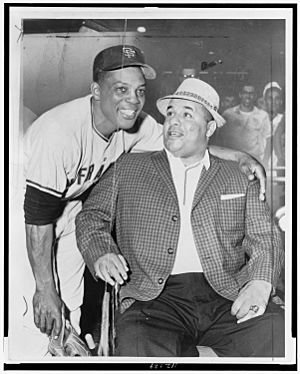
Campanella was interviewed on TV shows like Person to Person and What's My Line?. He also appeared in an episode of the TV show Lassie in 1959. In the episode, he coached a boys' baseball team.
Roy Campanella is mentioned in several songs. These include "Did You See Jackie Robinson Hit that Ball?" and "We Didn't Start the Fire" by Billy Joel. He is also in the song "Talkin' Baseball" by Terry Cashman.
Roy's Family Life
Roy Campanella was married three times. His last marriage was to Roxie Doles, who was with him until he died. He had children from his first two marriages. One of his sons, Roy Campanella II, became a television director.
Roy's Death
Roy Campanella died from heart failure on June 26, 1993. He was 71 years old. He passed away at his home in Woodland Hills, California.
Roy's Legacy
In 1999, The Sporting News ranked Campanella number 50 on its list of the 100 Greatest Baseball Players. He was also considered for the Major League Baseball All-Century Team.
Carl Erskine, a former Dodger pitcher, wrote a book called Carl Erskine's Tales from the Dodgers Dugout: Extra Innings (2004). This book includes many stories about Campanella.
Campanella wrote his own story, called It's Good to Be Alive, published in 1959. It talked about his recovery after his accident. A TV movie based on the book, also called It's Good to Be Alive, was made in 1974.
In 2006, Campanella was honored on a United States postage stamp. It was part of a set of four stamps honoring famous baseball players.
In September 2006, the Los Angeles Dodgers created the Roy Campanella Award. The team's players and coaches vote for this award every year. It is given to the Dodger who shows "Campy's" spirit and leadership.
A book about Campanella, titled Campy – The Two Lives of Roy Campanella, was published in 2011. It shares new details about his life and career.
A short film called "Roy Campanella Night" was released in 2013. It tells the story of his recovery and the special tribute night held for him in 1959.
|
See also
 In Spanish: Roy Campanella para niños
In Spanish: Roy Campanella para niños
- List of Major League Baseball career home run leaders
- List of Major League Baseball annual runs batted in leaders
- List of Major League Baseball players who spent their entire career with one franchise
- List of members of the Mexican Professional Baseball Hall of Fame
- List of Negro league baseball players who played in Major League Baseball


